Textural properties of faba bean-based Camembert analogue
DOI:
https://doi.org/10.23986/afsci.154813Keywords:
Vicia faba, plant-based food, dairy analogue, veganAbstract
As global food systems evolve toward sustainability, the demand for plant-based alternatives to traditional animal-derived products is growing. Faba beans (Vicia faba), known for their versatility and agricultural benefits, offer a promising solution in the development of vegan cheese analogues. This study explores the potential of using faba beans to produce a Camembert-like cheese. The Camembert analogues were formulated with fat contents of 15% and 30% and varying proportions of coconut and rapeseed oils in triplicate. The proportions of coconut and rapeseed oils were 40:60, 50:50, and 60:40. Generally, the Camembert analogues with the higher fat content (30%) resulted in higher hardness, springiness, chewiness, and dry matter content compared to the analogues with 15% fat. This suggests that fat content is more important for these parameters than proportions of coconut and rapeseed oil. Future research should focus on optimising texture to more closely replicate traditional dairy Camembert and meet consumer sensory expectations. Incorporating sensory evaluations and consumer feedback is essential to validate instrumental findings and ensure the product meets consumer expectations.
Downloads
Downloads
Published
Versions
- 2025-06-30 (2)
- 2025-04-30 (1)
Issue
Section
License
Copyright (c) 2025 Galia Zamaratskaia, Nariman Mousa, Fredrik Fogelberg, Oksana Kravchenko, Maud Langton

This work is licensed under a Creative Commons Attribution 4.0 International License.
How to Cite
Accepted 2025-04-22
Published 2025-06-30







